Iris Dutch: types and features of cultivation
Iris is a plant familiar to all Russian gardeners, but rhizomatous species, which are often called cockerels or killer whales, are still the most familiar to us. Bulbous iris still seems exotic to many, although in fact its cultivation is not difficult. The most common species is xyphyum, aka Dutch iris - a delicate plant with amazingly beautiful buds. Today, it can increasingly be found in flower shops, and it will not be difficult to grow such a miracle on the site.
Content:
- Appearance and features
- Basic rules for caring for irises on the site
- Planting bulbous irises
- Storage and planting of Dutch irises
- Iris cutting rules
Appearance and features
Dutch iris is a perennial bulbous plant that can be grown both outdoors and in a pot on a windowsill. There are common and dwarf varieties that differ in the size of the leaves and the length of the peduncles.
Its appearance is somewhat different from the usual rhizome irises:
- The bulb is usually small and bottle-shaped. Several narrow, dark green, pointed leaves develop from it.
- On unbranched shoots, single flowers are located, which can have a very different color.
- There are dozens of varieties of Dutch irises, many of which are bi-colored: closer to the middle of the bud, interesting color transitions can be observed.
- The buds can be blue, blue, yellow and other colors, this type of irises has a rich color palette, for which he received recognition from gardeners. These flowers are grown for cut and will never lose their popularity.
- In addition, there will always be a place for irises on the site, as they will become an adornment of any flower bed.
Most often in our latitudes grow blue iriswith yellow veins on the petals. It will look very beautiful, with complete undemanding care.
The height of the peduncle in ordinary varieties can reach 70 cm, in dwarf varieties it is no more than 20 cm.Irises are often used for forcing buds at home: if the growing technology is observed, graceful buds can be obtained around mid-January.
The peculiarity of xyphyum is that the flower can be called "two-story": first one bud blooms, and when it fades, a second flower appears.
Basic rules for caring for irises on the site
One of the main requirements: bulbous types of irises are very sensitive to excess moisture, since the roots and the bulb itself begin to rot very quickly. Because of this, you will definitely need to take care of organizing a drainage layer that removes excess moisture from the flower bed.
It is important to follow other rules for caring for irises:
- Iris need place in dry and light placesnor do they tolerate the open sun very well. The best option would be partial shade, but the flower bed should be positioned so that the leaves receive enough light.
- Growing irises requires a loose, nutritious soil that is either neutral or alkaline.
- If there is clay soil on the site, sand is necessarily added to the soil so that water does not stagnate, and slaked lime, which allows you to even out the desired acidity balance.
- Fertilizer must be approached carefully: irises do not tolerate a large amount of chemical dressings poorly, so it is better to use ordinary humus or compost, its amount should not exceed 1 bucket per meter of garden area. After planting the plants, the soil can be additionally fertilized with wood ash.
- Plants are sensitive to watering: the soil should not completely dry out, but excess moisture in the soil should not be allowed. Since rainy seasons are typical for Russian conditions, after flowering, the bulb must be dug up and stored.
Bulbous irises have a relatively short growing season: they begin to bloom in late May or early summer, but they quickly fade. It is important to choose the right seed: the bulbs can be purchased at the flower shop in packaging: they should not have soft areas, the color of a healthy bulb is golden without dark spots.
Planting bulbous irises
Iris planting is carried out in several stages. Compliance with the technology will allow you to get a good result:
- Before planting the seed treated with a solution of fugincide and dried to prevent decay. The soil is pre-shed with a pink solution of potassium permanganate to destroy pathogenic microbes.
- The distance between the bulbs should be at least 10-15 cm, depending on the selected variety, it is advisable to place them on a sandy "pillow" that will remove excess moisture.
- If the roots have already begun to appear on the bulbs, they can be planted in a small trench, the depth of which is up to 15 cm. Sand is poured at the bottom of the trench, the bulbs are placed on a bedding layer and covered with sand and then a layer of soil. The soil should not be overly dense, sometimes small pebbles or gravel are added to it as mulch.
- After covering the bulbs with soil, the planting is watered. After that, you can expect the rapid appearance of sprouts and peduncles.
Dutch iris usually begins to bloom at the end of Maysome varieties may be 15-20 days late. The buds will not please the eye for long, since they begin to fade rather quickly, They will stay fresh much longer if the weather is cool and cloudy outside. In the bright sun, on the contrary, the buds will quickly fade, and the time of flowering will end earlier than expected.
When the leaves are completely dry, the bulbs are dug up.
Storage and planting of Dutch irises
After digging, the bulb must be dried at a temperature of at least 30 degrees in this mode, they are kept for 2-4 weeks, depending on the variety. It is important to provide good ventilation for effective drying. After that, the bulbs can be moved to storage in a dry room, it is desirable to keep them at a temperature of 15-20 degrees.
You can start landing at the beginning of Indian summer before the first real cold weather.
Even during flowering, gardeners notice the color of the buds and then plant the bulbs in accordance with the expected type of flower bed. Planting will allow you to get new flowers the next summer if large bulbs were used for planting. Small ones can grow for another year before giving the first peduncle.
If the region is characterized by snowy winters, they do not cover planting for the cold season: a snow carpet will be enough. If the flower bed is located on a hill from which snow will blow off, it is better to take care of additional shelter... It is made from fallen leaves, you can use spruce branches or sawdust. The shelter is removed after the soil has thawed.
If there are no strong winds on the site, additional supports are not needed, sometimes pegs are additionally installed so that the peduncles do not break.
Planted irises can become a real decoration if you use several varieties with non-standard color combinations on one flower bed. It is the irises that open up a wide scope for imagination, since today you can buy plant bulbs with blue, purple, other blue buds.
Iris cutting rules
Cut bulbous irises last much longer than conventional irises. The term can be extended if you use settled water without chlorine, rainwater is an excellent solution.
Into it top dressing is applied:
- This can be a specialized formulation purchased from a store, or regular sugar (3 teaspoons per 2 liters).
- Top dressing will allow the flowers to fully open, and they will last longer.
An oblique cut of the stem must be done under water so as not to block the access to moisture. In water, the stem is cut several more times or pierced with a pin. The solution in the vase must be changed at least once every 3 days. As a result, it will be possible to provide plants with a long life and an excellent appearance.
Bulbous types of irises are becoming more and more popular: they attract flower growers with graceful buds and beautiful leaves, in addition, they are quite unpretentious plants.
If you decide to decorate the site with an exquisite flower bed with colorful petals, Dutch iris may be the best option. It is not difficult to look after him, and he will repay all worries with friendly flowering and magnificent buds.
More information can be found in the video.



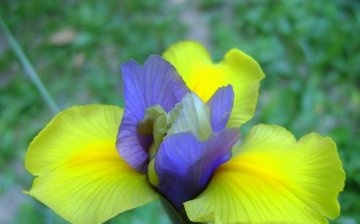
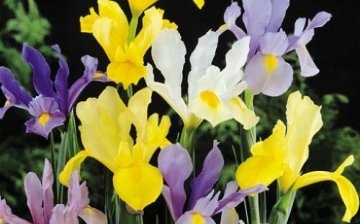
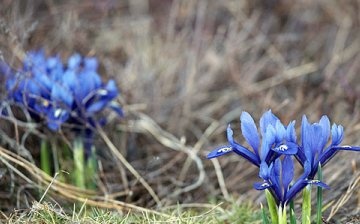
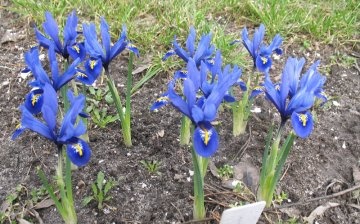

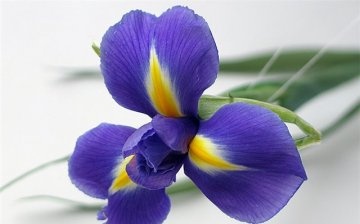






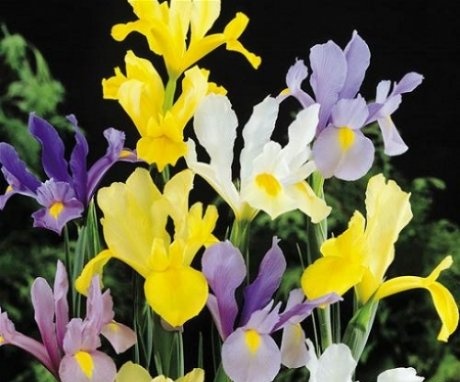
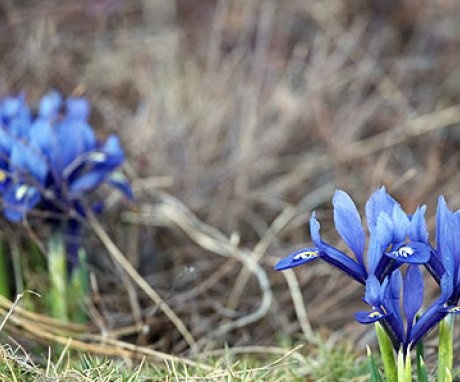
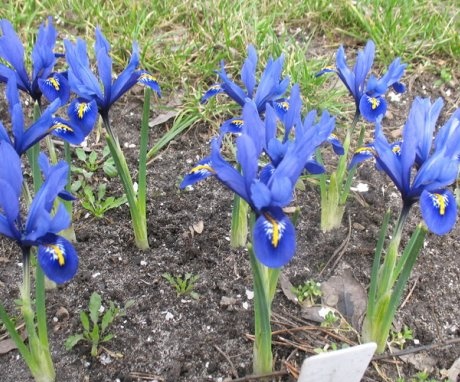

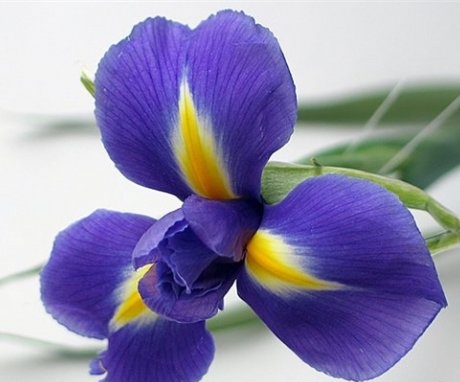
I bought iris bulbs and now I don't know what to do with them, I decided to plant them in peat pots before planting them in the ground. I read the article and realized that it is possible not to plant it in open ground - to grow it at home on the windowsill.